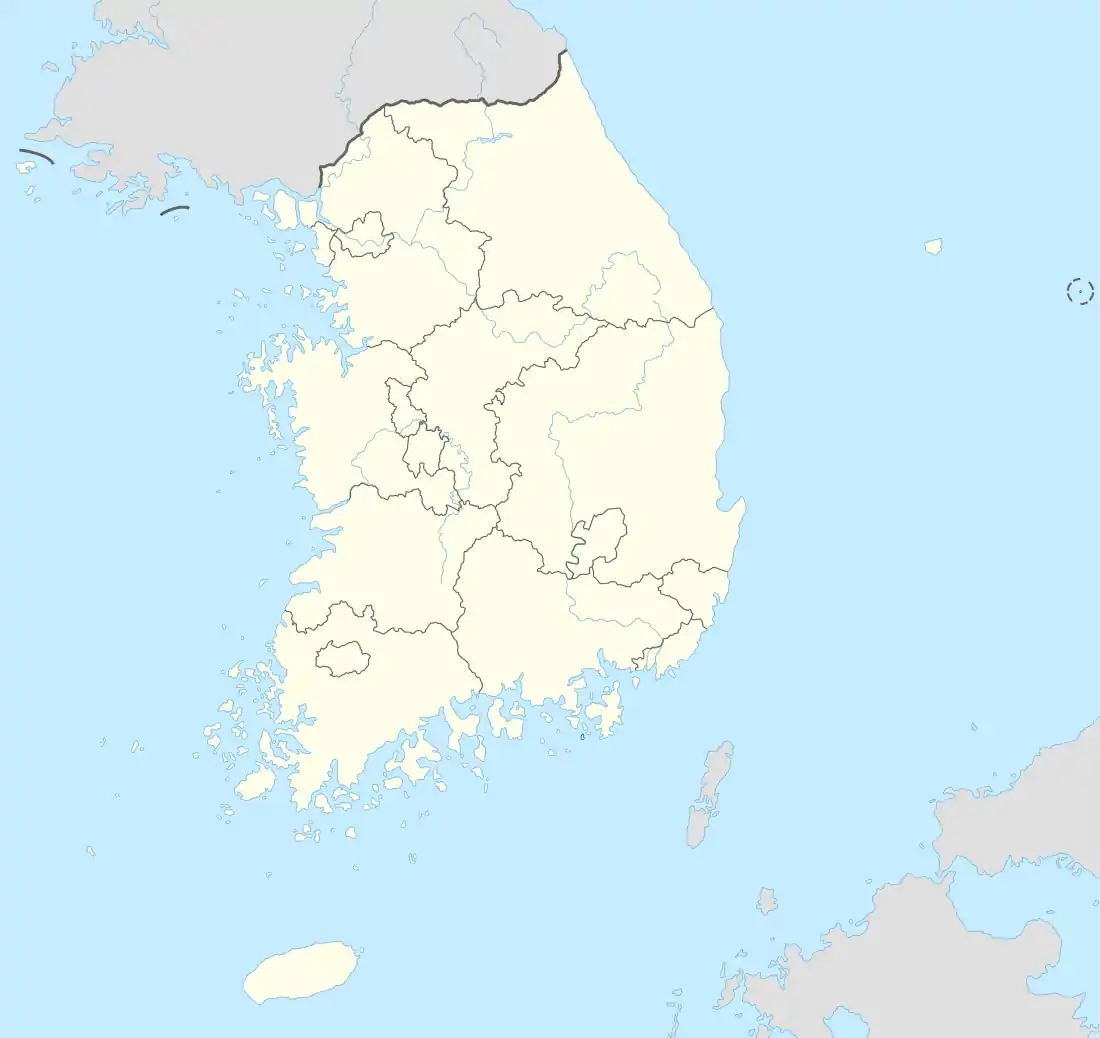Pyeongchang Olympic Stadium
The Pyeongchang Olympic Stadium (Korean: 평창 올림픽 스타디움) was a temporary venue for the opening and closing ceremonies of the 2018 Winter Olympics and Paralympics in Pyeongchang County, Gangwon Province, South Korea. The stadium was demolished after the Paralympic Games.
평창 올림픽 스타디움 | |
 The stadium during the 2018 Winter Paralympics opening ceremony | |
 Pyeongchang Olympic Stadium Location in South Korea | |
| Location | Pyeongchang, South Korea |
|---|---|
| Coordinates | 37.667°N 128.706°E |
| Capacity | 35,000[1] |
| Field size | Diameter: 72 m (236 ft) |
| Field shape | Circular |
| Acreage | 14.53 acres |
| Surface | Snow, Ice, Grass |
| Construction | |
| Built | 2015–2017 |
| Opened | 30 September 2017 |
| Closed | 21 March 2018 |
| Demolished | 2018 |
| Construction cost | ₩116 billion ($109 million) |
Background
It was located in Daegwallyeong-myeon, in the precinct of the Pyeongchang Olympic Plaza, about 2 km (1.2 mi) northeast of Alpensia Resort.
To limit its costs, the stadium had no roof or a central heating system. It cost ₩116 billion ($109 million).[2] The 35,000-seat stadium had seven floors above ground, a single floor underground,[3] and a pentagonal design.[4] It had a floor area of 58,790 square meters (632,800 sq ft) and its circular stage had a diameter of 72-meter (236 ft)[5]
Built on an 80,000 square meters (860,000 sq ft) site in Hoenggye, it was the final major structure built for these Games. The approximate elevation was 740 meters (2,430 ft) above sea level.
Adjacent to the stadium was an Olympic exhibition hall, traditional food markets, and other attractions, which would remain as heritage facilities, and the medal plaza which hosted medal ceremonies.
History
In the candidacy file of Pyeongchang 2018, the Opening and Closing Ceremonies were foreseen to take place in Alpensia Ski Jumping Stadium. This was a plan similar to the one of the 1994 Winter Olympics. However, in July 2012, the POCOG announced some changes in the venue plan and the ceremonies were moved to Hoenggye.[6] The main reasons were organisational, with possible interference between the preparation of the ceremonies and the ski jumping training, and the weather conditions for the spectators.
The construction of the stadium which took one year and ten months was completed on 30 September 2017.[5]
The Pyeongchang Olympic Stadium had been used 5 times before being demolished.[7] It was used as a K-pop concert venue of the 2017 Dream Concert in PyeongChang,[8] marking the 100 Days before the Olympics, the opening and closing ceremonies of the 2018 Winter Olympics, plus the opening and closing ceremonies of the 2018 Winter Paralympics.[2][9]
See also
- Théâtre des Cérémonies, a similar temporary facility for the 1992 Winter Olympics.
References
- "PyeongChang Olympic Stadium : PyeongChang 2018 Venue". Archived from the original on 2018-02-16. Retrieved 2017-12-08.
- Badalge, Keshia (3 February 2018). "The 2018 Winter Olympics Stadium That Cost $100 Million to Build, Will Only Be Used 4 Times, and Is Roofless". Arch Daily. Retrieved 6 March 2018.
- "PyeongChang Olympic Stadium". The PyeongChang 2018 Olympic and Parlaympic Winter Games. Archived from the original on 10 February 2018. Retrieved 6 March 2018.
- Dawood, Sarah (8 February 2018). "How the PyeongChang 2018 Winter Olympics was designed". Design Week. Retrieved 6 March 2018.
- JiAe, Sohn (1 October 2017). "PyeongChang stadium ready for Games". Korea.net. Retrieved 6 March 2018.
- Pyeongchang 2018 move venue for Opening and Closing Ceremonies - Inside the Games - 6 July 2012
- Weber, Sam (5 June 2018). "Here's What Pyeongchang Looks Like Now". CityLab. Retrieved 15 June 2018.
Like the snow, other signs of the Olympic effort, such as Pyeongchang’s disposable Olympic stadium, have simply vanished in the spring
- "평창 드림콘서트, 엑소+워너원 출연 '화려한 라인업 공개'" (in Korean). Retrieved 2018-07-15.
- Horwitz, Josh (25 January 2018). "South Korea's $100 million Winter Olympics stadium will be used exactly four times". Quartz. Retrieved 6 March 2018.
External links
| Wikimedia Commons has media related to PyeongChang Olympic Stadium. |
- Pyeongchang Olympic Stadium on "Pyeongchang 2018" website
| Preceded by Fisht Olympic Stadium Sochi |
Winter Olympics Opening and Closing Ceremonies (Olympic Stadium) 2018 |
Succeeded by Beijing National Stadium Beijing |